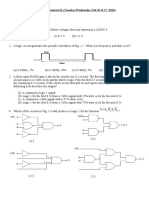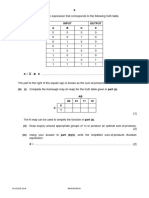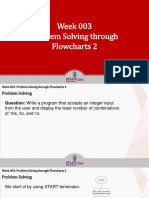Simplification of Boolean Functions Using K-Map Method
Simplification of Boolean Functions Using K-Map Method
Uploaded by
GatesCopyright:
Available Formats
Simplification of Boolean Functions Using K-Map Method
Simplification of Boolean Functions Using K-Map Method
Uploaded by
GatesOriginal Title
Copyright
Available Formats
Share this document
Did you find this document useful?
Is this content inappropriate?
Copyright:
Available Formats
Simplification of Boolean Functions Using K-Map Method
Simplification of Boolean Functions Using K-Map Method
Uploaded by
GatesCopyright:
Available Formats
Name: Atienza, Raymond Angelo M.
Date Performed: 01/12/21
Alaan, Angelica B.
Monteiro, Franchesca Date Submitted: 01/16/21
Course: COE 3-1
Experiment No. 3
SIMPLIFICATION OF BOOLEAN FUNCTIONS USING K-MAP
METHOD
I. OBJECTIVE
1. To use Karnaugh map to simplify Boolean expressions.
2. To implement logic circuits using logic gates.
II. MATERIALS
− Logic gates IC’s
− Breadboard
− Connecting wires
− Power Supply
− LED’s
III. THEORY
Karnaugh maps or K-maps for short, provide another means of simplifying and
optimizing logical expressions. This is a graphical technique that utilizes a sum of product
(SOP) form. SOP forms combine terms that have been ANDed together that then get ORed
together. This format lends itself to the use of De Morgan's law which allows the final result
to be built with only NAND gates. The K-map is best used with logical functions with four or
less input variables. One of the advantages of using K-maps for reduction is that it is easier to
see when a circuit has been fully simplified. Another advantage is that using K-maps leads to
a more structured process for minimization.
In order to use a K-map, the truth table for a logical expression is transferred to a K-
map grid. The grid for two, three, and four input expressions are provided in the tables below.
Each cell corresponds to one row in a truth table or one given state in the logical expression.
The order of the items in the grid is not random at all; they are set so that any adjacent cell
differs in value by the change in only one variable. Because of this, items can be grouped
together easily in rectangular blocks of two, four, and eight to find the minimal number of
groupings that can cover the entire expression.
Engr. Pablo B. Asi Engr. Leni A. Bulan Engr. Liza R. Maderazo
IV. PROCEDURE
1. BCD invalid code detector
BCD is a 4-bit binary code representing the decimal numbers 0 through 9. The binary
numbers 1010 through 1111 are not used in BCD.
a) Construct a truth table containing all possible inputs and desired output. Assume that the
desired output for a valid code is a 1, and for an invalid code is 0. Complete the truth table
as shown in Table 3.1. A is the most significant bit, and D is the least significant bit.
Table 3.1
A B C D X
0 0 0 0 1
0 0 0 1 1
0 0 1 0 1
0 0 1 1 1
0 1 0 0 1
0 1 0 1 1
0 1 1 0 1
0 1 1 1 1
1 0 0 0 1
1 0 0 1 1
1 0 1 0 0
1 0 1 1 0
1 1 0 0 0
1 1 0 1 0
1 1 1 0 0
1 1 1 1 0
Engr. Pablo B. Asi Engr. Leni A. Bulan Engr. Liza R. Maderazo
b) Draw the Karnaugh map, and write the simplified Boolean expression for the valid
codes as sum of products.
c) Draw the circuit for the above simplified Boolean expression and implement using the
Multisim.
Engr. Pablo B. Asi Engr. Leni A. Bulan Engr. Liza R. Maderazo
Engr. Pablo B. Asi Engr. Leni A. Bulan Engr. Liza R. Maderazo
Engr. Pablo B. Asi Engr. Leni A. Bulan Engr. Liza R. Maderazo
Engr. Pablo B. Asi Engr. Leni A. Bulan Engr. Liza R. Maderazo
Engr. Pablo B. Asi Engr. Leni A. Bulan Engr. Liza R. Maderazo
2. Boolean Functions (1)
a. Simplify the following two Boolean functions by means of Karnaugh maps.
F1 (A, B, C, D) = Σm (0,1,4,5,8,9,10,12,13)
F2 (A, B, C, D)= Σm (3,5,7,8,10,11,13,15)
Engr. Pablo B. Asi Engr. Leni A. Bulan Engr. Liza R. Maderazo
b. Implement and draw the logic diagrams for outputs F1 and F2 in terms of the inputs A,
B, C, and D.
Engr. Pablo B. Asi Engr. Leni A. Bulan Engr. Liza R. Maderazo
c. Connect the circuit and verify it’s operation by preparing a truth table for F1 and F2
similar to Table 3.1.
Verification of values (F1)
A B C D F1 F2
0 0 0 0 1 0
0 0 0 1 1 0
0 0 1 0 0 0
0 0 1 1 0 1
0 1 0 0 1 0
0 1 0 1 1 1
0 1 1 0 0 0
0 1 1 1 0 1
1 0 0 0 1 1
1 0 0 1 1 0
1 0 1 0 1 1
1 0 1 1 0 1
1 1 0 0 1 0
1 1 0 1 1 1
1 1 1 0 0 0
1 1 1 1 0 1
Engr. Pablo B. Asi Engr. Leni A. Bulan Engr. Liza R. Maderazo
Engr. Pablo B. Asi Engr. Leni A. Bulan Engr. Liza R. Maderazo
Engr. Pablo B. Asi Engr. Leni A. Bulan Engr. Liza R. Maderazo
Engr. Pablo B. Asi Engr. Leni A. Bulan Engr. Liza R. Maderazo
Verification of values F2
AB'D' + BD + CD
Engr. Pablo B. Asi Engr. Leni A. Bulan Engr. Liza R. Maderazo
Engr. Pablo B. Asi Engr. Leni A. Bulan Engr. Liza R. Maderazo
Engr. Pablo B. Asi Engr. Leni A. Bulan Engr. Liza R. Maderazo
Engr. Pablo B. Asi Engr. Leni A. Bulan Engr. Liza R. Maderazo
3. Boolean Functions (2)
a. Derive a truth table for the following Boolean Functions.
F=A’D+B’D+BC+AB’D
A B C D F F’
0 0 0 0 0 1
0 0 0 1 1 0
0 0 1 0 0 1
0 0 1 1 1 0
0 1 0 0 0 1
0 1 0 1 1 0
0 1 1 0 1 0
0 1 1 1 1 0
1 0 0 0 0 1
1 0 0 1 1 0
1 0 1 0 0 1
1 0 1 1 1 0
1 1 0 0 0 1
1 1 0 1 0 1
1 1 1 0 1 0
1 1 1 1 1 0
b. Draw a Karnaugh map. Combine all the 1’s to obtain the simplified function for F.
Combine all the 0’s to obtain the simplified function for F’.
SOP= A’D + BC + B'D
POS = (A+D') (B'+C') (B+D')
Engr. Pablo B. Asi Engr. Leni A. Bulan Engr. Liza R. Maderazo
c. Draw both circuits and implement using the multisim
SOP= A’D + BC + B'D
POS = (A+D') (B'+C') (B+D')
V. DISCUSSION QUESTIONS
Engr. Pablo B. Asi Engr. Leni A. Bulan Engr. Liza R. Maderazo
Verification of values
SOP= A’D + BC + B'D
Engr. Pablo B. Asi Engr. Leni A. Bulan Engr. Liza R. Maderazo
Engr. Pablo B. Asi Engr. Leni A. Bulan Engr. Liza R. Maderazo
Engr. Pablo B. Asi Engr. Leni A. Bulan Engr. Liza R. Maderazo
Engr. Pablo B. Asi Engr. Leni A. Bulan Engr. Liza R. Maderazo
Verification of values POS = (B'+C')(A+D')(B+D')
Engr. Pablo B. Asi Engr. Leni A. Bulan Engr. Liza R. Maderazo
Engr. Pablo B. Asi Engr. Leni A. Bulan Engr. Liza R. Maderazo
Engr. Pablo B. Asi Engr. Leni A. Bulan Engr. Liza R. Maderazo
Engr. Pablo B. Asi Engr. Leni A. Bulan Engr. Liza R. Maderazo
V. DISCUSSIONS
1. Use a Karnaugh map to find the minimum (SOP) form for the expression:
F = A’B’C’D’ + A’B’CD’ + AB’C’D’ + AB’CD’
2. Use a Karnaugh map to find the minimum (SOP) & (POS) form for the expression:
F = A’B’C’D’ + A’B’C’D + A’B’CD + A’BC’D’ + A’BC’D + A’BCD +
ABC’D’ + ABC’D + ABCD
Engr. Pablo B. Asi Engr. Leni A. Bulan Engr. Liza R. Maderazo
VI. CONCLUSION
After analyzing the structure of Kmaps, we came to the conclusion that the Kmap
Simplification process is an effective reduction method in logical terms containing three
to six input variables . Multisim KMap method simplifies circuit creation and design. It
provides a simple graphical way to simplify Boolean expressions.
Engr. Pablo B. Asi Engr. Leni A. Bulan Engr. Liza R. Maderazo
Screenshots
Engr. Pablo B. Asi Engr. Leni A. Bulan Engr. Liza R. Maderazo
Engr. Pablo B. Asi Engr. Leni A. Bulan Engr. Liza R. Maderazo
You might also like
- Stage 5 Check 12 AnswersDocument1 pageStage 5 Check 12 AnswersginnellyzoeNo ratings yet
- Mathematics MELCsDocument68 pagesMathematics MELCsRanjell Allain Torres100% (2)
- Experiment 7Document7 pagesExperiment 7Karan KumarNo ratings yet
- PHAL Visoth E20200158Document5 pagesPHAL Visoth E20200158Visoth PhalNo ratings yet
- Digital Circuits-I LAB: Jadavpur UniversityDocument15 pagesDigital Circuits-I LAB: Jadavpur UniversityIron PatriotNo ratings yet
- Digital Electronics - Tutorial #4Document2 pagesDigital Electronics - Tutorial #4Dishawn Nation100% (1)
- ASSIGNMENT 1 - VerilogDocument3 pagesASSIGNMENT 1 - VerilogfiitnessbynehaNo ratings yet
- Assignment1 SolutionDocument8 pagesAssignment1 SolutionSyed Abdullah Hasan ChishtiNo ratings yet
- HuwDocument12 pagesHuwCharles MorganNo ratings yet
- Digital DesignDocument4 pagesDigital DesignHasan CanarslanNo ratings yet
- VLSI Lab Report 2Document5 pagesVLSI Lab Report 2Abdullah Al AzmeNo ratings yet
- DLD ExamDocument1 pageDLD Examhanzila farukeNo ratings yet
- Lab 3Document7 pagesLab 32221634No ratings yet
- Odd Parity GeneratorDocument2 pagesOdd Parity Generatorzain chaudharyNo ratings yet
- Activity2 2623Document14 pagesActivity2 2623ryle34No ratings yet
- Final Solution Manual v2Document13 pagesFinal Solution Manual v2SSTGingNo ratings yet
- Logic Gates ActivityDocument5 pagesLogic Gates ActivityKAYLEIGH YOUNG (Student)No ratings yet
- DLD Lab 5 by UtwDocument9 pagesDLD Lab 5 by Utwurwa tilwusqaNo ratings yet
- Experiment 3 - CSC 204 LabDocument7 pagesExperiment 3 - CSC 204 Lab2221634No ratings yet
- Assignment 2Document38 pagesAssignment 2MD. Akif RahmanNo ratings yet
- Ee222 Lab 3Document9 pagesEe222 Lab 3Jakob NandNo ratings yet
- EE 271 - LAB 1: Danang University of Technology and ScienceDocument5 pagesEE 271 - LAB 1: Danang University of Technology and ScienceDuong ThaiNo ratings yet
- School of Engineering and Physics EE222 Lab 5Document9 pagesSchool of Engineering and Physics EE222 Lab 5Alvish NaiduNo ratings yet
- De 211 AOI TruthTables LogicExpressionsDocument14 pagesDe 211 AOI TruthTables LogicExpressionsColin BurressNo ratings yet
- Question NoDocument2 pagesQuestion Noapi-3767350No ratings yet
- BSCS23091 DLD Lab 12Document5 pagesBSCS23091 DLD Lab 12ilyhafaNo ratings yet
- Final Exa1Document3 pagesFinal Exa1Badr BouhsinaNo ratings yet
- Assignment 1 DGEN245 Digital ElectronicDocument3 pagesAssignment 1 DGEN245 Digital ElectronicAja AzizNo ratings yet
- Digital ReportDocument31 pagesDigital ReportdommarajurahulvarmaNo ratings yet
- BI2002B - Circuitos LógicosDocument30 pagesBI2002B - Circuitos LógicosHéctor Vega SantamaríaNo ratings yet
- GROUP-6 ProjectDocument7 pagesGROUP-6 ProjectAldrin MndzNo ratings yet
- Digital Electronics - Tutorial #1Document3 pagesDigital Electronics - Tutorial #1Dishawn NationNo ratings yet
- 1.3.1 Logic GatesDocument14 pages1.3.1 Logic Gatessaad nasirNo ratings yet
- CS 1104 Unit 2 AssignmentDocument4 pagesCS 1104 Unit 2 AssignmentOmar Dye CeesayNo ratings yet
- Task 1: Make The Circuit of 2-Bit Magnitude Comparator and Fill The Truth Table. Solution: Truth TableDocument4 pagesTask 1: Make The Circuit of 2-Bit Magnitude Comparator and Fill The Truth Table. Solution: Truth Tablewaleed infoNo ratings yet
- Exam Discrete StructureDocument6 pagesExam Discrete StructureB9 - 25 - Hà Bảo NhiNo ratings yet
- Digital Electronics Answer Sheet 3Document1 pageDigital Electronics Answer Sheet 3Arial96No ratings yet
- Assignment 03 Solution FinalDocument9 pagesAssignment 03 Solution Finalmaroua.sayahNo ratings yet
- Low Power Ic Design: Digital Assignment-1Document19 pagesLow Power Ic Design: Digital Assignment-1Prìñçé ÅsîfNo ratings yet
- Assignment 3 Boolean algebra - Nguyễn Quốc An - BTECC01K10TDocument9 pagesAssignment 3 Boolean algebra - Nguyễn Quốc An - BTECC01K10TKatonguyenNo ratings yet
- Experiment 3 - CSC 204L-1Document6 pagesExperiment 3 - CSC 204L-1shirazimmunirsetsNo ratings yet
- Multiplexer Dan DemultiplexerDocument1 pageMultiplexer Dan Demultiplexersilvia rohmaNo ratings yet
- EEE 180.1 Lab3Document4 pagesEEE 180.1 Lab3Enrico PonceNo ratings yet
- Aim: Sofware Used: TheoryDocument2 pagesAim: Sofware Used: TheoryTigerNo ratings yet
- Lab 3Document8 pagesLab 3nhiphan4303No ratings yet
- DLD HWDocument17 pagesDLD HWNấm LùnNo ratings yet
- Kaidah Gerbang Dasar Menngunakan Ewb 1. Gerbang ANDDocument10 pagesKaidah Gerbang Dasar Menngunakan Ewb 1. Gerbang ANDdanielalumbantobingNo ratings yet
- DIGIELECS1 Quiz2Document1 pageDIGIELECS1 Quiz2Jonathan DavidNo ratings yet
- EXPERIMENT # 5 - ECE 3A Cruz, JairehDale FDocument4 pagesEXPERIMENT # 5 - ECE 3A Cruz, JairehDale FJaireh Dale CruzNo ratings yet
- Devri PDF Gerbang LogikaDocument5 pagesDevri PDF Gerbang LogikaDevri MaryadiNo ratings yet
- DLD Assignment#2Document3 pagesDLD Assignment#2Muhammad AliNo ratings yet
- DLD Exp 4Document8 pagesDLD Exp 4Muhammad UsmanNo ratings yet
- Hashing (SHA 1)Document3 pagesHashing (SHA 1)Lloyd ZaneNo ratings yet
- Fikri Fadhlurrohman Ramdhani - 432007006180057Document4 pagesFikri Fadhlurrohman Ramdhani - 432007006180057segam juniorNo ratings yet
- 2.1.1.a AOITruthTablesToLogicExpressionsDocument6 pages2.1.1.a AOITruthTablesToLogicExpressionsmkorlbeastNo ratings yet
- MUCLecture 2022 37407Document5 pagesMUCLecture 2022 37407ajay KambleNo ratings yet
- Parhan Pariz Alamsyah - 20214121046 - TUGAS4 - Rangkaian DigitalDocument3 pagesParhan Pariz Alamsyah - 20214121046 - TUGAS4 - Rangkaian DigitalMR LembayungNo ratings yet
- Series 1 Basic Tools of Combinational LogicDocument3 pagesSeries 1 Basic Tools of Combinational LogicChelsea LavonyaNo ratings yet
- Government College University, Faisalabad Department of PhysicsDocument1 pageGovernment College University, Faisalabad Department of PhysicsMuhammad Ajaz-un-NabiNo ratings yet
- HardwareDocument64 pagesHardwarecharlesma463No ratings yet
- Cse 206 - Lab 05Document4 pagesCse 206 - Lab 05Syed IrfanNo ratings yet
- Binary Hex CA SOPDocument11 pagesBinary Hex CA SOPGatesNo ratings yet
- Adders and SubtractorsDocument17 pagesAdders and SubtractorsGatesNo ratings yet
- Boolean Algebra and Simplification of Logic EquationsDocument16 pagesBoolean Algebra and Simplification of Logic EquationsGatesNo ratings yet
- Digital Logic GatesDocument15 pagesDigital Logic GatesGatesNo ratings yet
- Leiterman J C 3264bit 80x86 Assembly Language ArchitectureDocument426 pagesLeiterman J C 3264bit 80x86 Assembly Language ArchitecturebarmoglotNo ratings yet
- MATHCOUNTS 2014 Chapter Competition - Team RoundDocument4 pagesMATHCOUNTS 2014 Chapter Competition - Team RoundJeff Shen100% (1)
- W3-Presentation-Problem Solving Through Flowcharts 2Document16 pagesW3-Presentation-Problem Solving Through Flowcharts 2Mikedaniel SalemNo ratings yet
- Mean, Median, and Mode: Lesson 7-1Document8 pagesMean, Median, and Mode: Lesson 7-1Dollar GNo ratings yet
- Phpmysql 04 PHP Data TypesDocument18 pagesPhpmysql 04 PHP Data TypesAbshir AhmedNo ratings yet
- Ahelm 104Document60 pagesAhelm 104Khalid Meqdad0% (1)
- Math GR8 Common Monomial FactorDocument42 pagesMath GR8 Common Monomial FactormamaineejannNo ratings yet
- Antiderivatives: FX GX HX F X GX HXDocument10 pagesAntiderivatives: FX GX HX F X GX HXJazmine FriasNo ratings yet
- Objectiv e Subject IveDocument5 pagesObjectiv e Subject IveHusna AdilaNo ratings yet
- 1st Lecture - Number - System, IEEE754Document51 pages1st Lecture - Number - System, IEEE754arshpreetmundra14No ratings yet
- 6 Limits and AccuracyDocument6 pages6 Limits and AccuracyAlya Afifi0% (1)
- Divisibility Questions With Solutions: 4-5 MinutesDocument5 pagesDivisibility Questions With Solutions: 4-5 Minutesscouty_sNo ratings yet
- Complex NumbersDocument2 pagesComplex NumbersGarv ChardNo ratings yet
- LAS BASIC CALCULUS WK5 Fo StudDocument12 pagesLAS BASIC CALCULUS WK5 Fo StudMariane ManalastasNo ratings yet
- Harvard Algorithm Course NotesDocument6 pagesHarvard Algorithm Course NotesYamini DasguptaNo ratings yet
- AP Calc BC Summer AssignmentDocument3 pagesAP Calc BC Summer AssignmentSpicyExplosionNo ratings yet
- Vedic MathameticsDocument220 pagesVedic MathameticsDanielle WilliamsonNo ratings yet
- Chapter 3.1, DerivativesDocument11 pagesChapter 3.1, DerivativesaungminsfuNo ratings yet
- Absar School and College Timergara: Q1: Tick The Correct OptionDocument1 pageAbsar School and College Timergara: Q1: Tick The Correct OptionAftab hussainNo ratings yet
- Adding and Subtracting Fractions WorksheetDocument8 pagesAdding and Subtracting Fractions WorksheetShaimaa BakiaNo ratings yet
- DLL Mathematics 1 q2 w5Document5 pagesDLL Mathematics 1 q2 w5Maia AlvarezNo ratings yet
- Fractions-Decimals-And-Percentages (Test 210424) - 240421 - 174458Document7 pagesFractions-Decimals-And-Percentages (Test 210424) - 240421 - 174458Dimple SoniNo ratings yet
- Math6-Q1 Mod9 Terminating RepeatingDecimals Version3Document20 pagesMath6-Q1 Mod9 Terminating RepeatingDecimals Version3Jerry Angelo MagnoNo ratings yet
- Arithmetic Sequence NTH Term Arithmetic Means and Arithmetic Series 1Document35 pagesArithmetic Sequence NTH Term Arithmetic Means and Arithmetic Series 1Janniele Dela PeñaNo ratings yet
- 04 Mathematics (Bases)Document11 pages04 Mathematics (Bases)elishabagalwNo ratings yet
- Two Irrational Numbers Whose Sum Is RationalDocument4 pagesTwo Irrational Numbers Whose Sum Is RationalnishagoyalNo ratings yet
- P.6 Maths Lesson Notes Term Ii 2020Document67 pagesP.6 Maths Lesson Notes Term Ii 2020sanju BarmanNo ratings yet
- Rakshit Maths M&DDocument4 pagesRakshit Maths M&DRida SamreenNo ratings yet





























































































